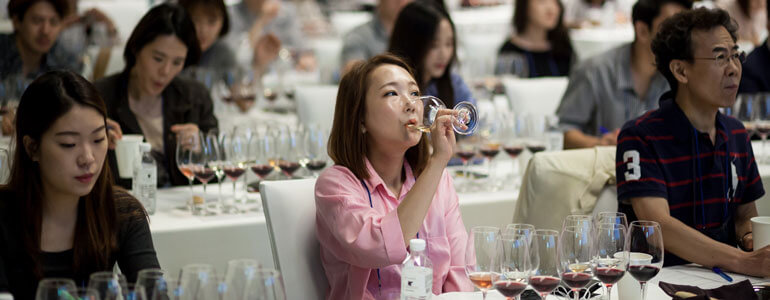Japan and South Korea are growing markets with opportunities for Australian wine and many exporters are exploring these two markets.
New information and consumer insights specific to the opportunities for the Australian category in the two markets was recently published in the Starburst Insights report, Uncorking new opportunities for Australian Wine in Japan & South Korea.
The report highlights key consumer understandings of the wine beverage category and the perception of Australian wine within these two markets. These insights provide the foundation for Australian wine businesses to better understand this consumer, placing them in a position to reap the benefits of these valuable markets.

Commissioned by Australian Grape & Wine using funding received through the Department of Agriculture, Fisheries and Forestry’s Agricultural Trade and Market Access Cooperation (ATMAC) grants program, this research was designed to assist the Australian wine sector to grow demand in diversified international markets for the category. The recent appointments of Rosemary MacDonald and Suzie Chung as the new Country Managers in Japan and South Korea was also funded through the same grant package, further increasing the sector’s focus and resourcing in the two markets.
The research identified three major areas for the Australian wine sector to consider:
- Back to basics – developing the wine category
- Standing for something – positioning Australian wine
- Making wine more accessible – overcoming barriers
While the report combines the findings from the two markets, its important to note that there are fundamental differences between the two that need to be considered. One strategy will not fit both markets.
Back to basics – developing the wine category
There is room to increase the number of wine drinkers in both markets, particularly with the strong wine conversion rates among their consumers (just over 60 per cent of wine considerers go on to purchase in each market).
However, while there is strong interest in wine in both Japan and South Korea, there is little objective knowledge. Thus, there is still a category job to do in both markets as wine is not seen as an everyday beverage of choice for a wide range of occasions. Wine is seen as luxurious and indulgent, and is dominated by French and Italian wine. This makes it difficult for Australian wines to grow share as they are viewed by Japanese and South Korean consumers as ‘value for money’ as opposed to ‘luxury’. Furthermore, even if the markets were to shift, ‘value for money’ is not a unique attribute for Australian wine to own – there needs to be an aspirational, emotive element for consumers to gravitate towards.

The key is fitting into consumers’ habits, rather than trying to change them. It is important to build accessibility of wine through building knowledge as well as building new occasions around ‘everyday premium’ to break down barriers to consumption. In particular:
- Food and wine pairing is important – create retail events, digital collateral, and trade education assets that help consumers pair wine with popular dishes.
- Create new occasions for wine, especially at-home and low tempo socialising.
- Be where they are – for example, how do we get our wines into venues like Izakayas?
There is a larger gap to bridge in South Korea than In Japan when building these new occasions. In Japan, the main motivations to drink wine are indulgence and status and to celebrate with family and share an intimate moment. South Koreans have fewer perceived reasons to drink wine. Currently, wine is distinctive only for indulgence and be seen to be trendy.
The research suggests re-defining what premium means in these markets by making special moments more accessible. And then move wine into a social and casual territory focused on connecting and bonding with friends and family by demonstrating wines can be for non-milestone birthdays, larger social gatherings and spontaneous catchups or occasions.
Standing for something – positioning Australian wine
Currently, only 3 per cent of consumers in both Japan and South Korea prefer Australian wines and the category has a conversion rate of around 15 per cent from those who consider purchasing it. One possible reason for this low conversion rate is that there is no defining position for Australian wine among consumers.
While trade awareness is good, consumers have little to no emotive connection with Australian wine. Many Japanese and South Korean consumers see Australian wine as lacking in differentiation. Australian wine is mainly known as being accessible and affordable but not premium.

However, Australia as a country creates strong image and associations for consumers that could be leveraged. For example, ‘Relaxed excellence’ is a compelling personality in these markets that resonates with drinkers and is uniquely Australian. ‘Sustainable’ and ‘natural’ are also strongly associated with Australia and are appealing to wine consumers. These traits can be leveraged to position Australian wine as the ideal country for ‘everyday premium’ to carve a space for Australian wines away from French and Italian wines.
There is a need to build an emotive connection with consumers that moves the category beyond past positioning, while replicating how compelling and attractive it was at the time. The sense of place and people that is the essence of wine, but links to what Australia as a brand means to consumers is key, as is being clear who we’re talking to and what we’re trying to say.

The research offers three suggested pathways:
- educate the consumers on Australian wine flavours and suitable wine pairings such as matching Australian wine to local and Australian/western cuisine
- unclutter the category to make it easy to see a role for Australian wine such as creating intuitive links between varietal and occasion and improving visibility at point of sale, and
- facilitate easier ways for consumers to try Australian wine, such as smaller bottle sizes to encourage trial with low risk, especially in Japan.
The research identified some potential opportunities for Australian wine:
- Red wine is the most consumed wine type in both South Korea and Japan.
- White and sparkling wine are chosen for their refreshing notes.
- Rosé has the desirable flavour characteristics that consumers are looking for but little is known about it - is there an opportunity for Australia to own the rosé category?
- Leveraging quality perception from other Australian produce – Australian meats are well known and regarded in both the South Korean and Japanese markets and so there may be an opportunity to partner with Meat and Livestock Australia.
- Leveraging agri-tourism in Australia – can food and wine pairings feature as one of the top 20 things to do in Australia?

In is important to note that the taste palates of Japanese and South Koreans differ significantly resulting in different wine types and food pairings. Japan as a lot of delicate and subtle food flavours thus Australian wines that are fruity, sweet, and refreshing may be more suitable. South Koreans are known for enjoying rich and spicy flavours so smooth, sweet, and rich wines may be more complimentary with South Korean cuisine.
Making wine more accessible – overcoming barriers
Whether it’s recruiting new drinkers, or increasing occasions for existing drinkers, consistent feedback from the research is that the category is confusing for many consumers. This creates barriers to trial and exploration.
There is an opportunity to position Australia as the region that helps decode wine and removes the confusion and impenetrability that surrounds wine for many consumers in these markets. Whether it’s on the pack, through digital/social comms, or at events, there are opportunities to be the country that partners with consumers to help them navigate the category.
Innovation in product and packaging to help consumers into the category, and to encourage exploration once they’re there is critical.

Summary
In summary, it is vital to seek to understand the consumer in each market. How can Australian wine fit into their lifestyles and using their language breaks down barriers. Understanding the overall market dynamics is also critical in helping wine producers make better business decisions. And finally, one voice is easier to understand than many voices thus working together in building the Australian wine category in each market is more efficient and effective.
Country Manager for Japan Rosemary MacDonald said, “Japan is a highly competitive market, but there is a great opportunity to share the story of premium Australian wine. We are highly diverse with a breadth of wine styles and grape varieties, crafted by skilled winemakers using sustainable practices across a continent of regions. Localised messaging, food pairings, education and creating opportunities to try Australian wine in Japan will be key tools to communicate the quality of Australian wine and intrigue new customers and consumers.”
Country Manager for South Korea Suzie Chung said, "For Korean wine lovers, wine represents a relaxed lifestyle with money to indulge and de-stress. Sensitive to price, they are curious about the story of wine and credentials. There is a perception that Australian wine is excellent in quality, delicious, and has good cost performance. And now Korean wine lovers are ready to learn about the natural environment, people, winemaking, food pairing and lifestyle of Australian wine. Please, continue to tell your story so that Koreans can open-up to Australian wine. They will realise that Australia is producing a variety of styles of wine and want to taste them. The heart of an Australian wine producer will surely touch the heart of a Korean wine lover."
The full report can be downloaded here.
